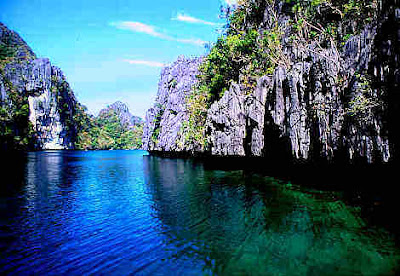





At A SPEED OF LESS THAN 20 KPH I can still feel the bumps. Yet I forget my discomfort every time the landscape changes,which is often. Half an hour ago we passed a thick mangrove purportedly infested with the crocodiles. Right now, web are in the middle of a lush rainforest,denser than Subic's,with monkeys that stare at us with the curious eyes before dissapearing into the foliage.
Palawan, the fluke- shaped island located southwest of the Philppines, is known as the country's last ecological frontier.It has more protected areas tha any other province in the Philppines.Thes include Calauit Wildlife Sanctuary in the northern Calamianes Islands, El Nido Marine Reserve, Tubbatha Reef in Sulu Sea, ST. Paul Subterranean National Park, and Ursulas Island. It is home to 232 endemic species of wildlife including the Talking Myna (Tiyaw).the Palawan Hornbill (Talusi).the Palawan Peacock Pheasant (Tandikan),the Porcupine (Durian), the scaly Anteater (Balintong), the Deer (Pilandok).Much of the national and local government's efforts is focused on keeping the environment pristine. In 1967, the entire province was declared a Fish and Wildlife Sanctuary; in 1993, commercial logging was totally banned. Today in its provincial capital city, littering is penalized heavily.
for Arlene and I, the name Palawan conjures magical in images. Out first trip together was to Club Noah Isabelle in Apulit Island, Northern Palawan Here, we woke up to the hoarse croaks of egrets, had barbeque lucnh oa stretch of white sand accented by an enchanting siamese acacia tree, and enjoyed cocktails inside a secret cave with candles and the notes from an acoustic guitar. Sky was the limit that night- or was it? The romantic chamber opened up to the stars. In between meals, we either dove or snorkeled in the clear water-just a short wade from our native cabana on stilts- to see, touch, or feed schools of snappers, groupers,butterflyfishes,wrasses and damselfishes below, Fifteen minutes into our introductory dive,we saw a rare encounter , an adult hawksbill turtle (Pawikan) foraging the surface for sea grass. In our excitement, we kept on flashing flashing the "OK" hand sign to each other. From the backseat,I peer into the side mirror and see Arlene sleeping in front. I half wish we were back in the idyllic poolside of Hotel Fleuris. but we asked for this- to see the other faces of Palawan, the country's largest province covering 1,768 millions hectares.
Palawan, the fluke- shaped island located southwest of the Philppines, is known as the country's last ecological frontier.It has more protected areas tha any other province in the Philppines.Thes include Calauit Wildlife Sanctuary in the northern Calamianes Islands, El Nido Marine Reserve, Tubbatha Reef in Sulu Sea, ST. Paul Subterranean National Park, and Ursulas Island. It is home to 232 endemic species of wildlife including the Talking Myna (Tiyaw).the Palawan Hornbill (Talusi).the Palawan Peacock Pheasant (Tandikan),the Porcupine (Durian), the scaly Anteater (Balintong), the Deer (Pilandok).Much of the national and local government's efforts is focused on keeping the environment pristine. In 1967, the entire province was declared a Fish and Wildlife Sanctuary; in 1993, commercial logging was totally banned. Today in its provincial capital city, littering is penalized heavily.
for Arlene and I, the name Palawan conjures magical in images. Out first trip together was to Club Noah Isabelle in Apulit Island, Northern Palawan Here, we woke up to the hoarse croaks of egrets, had barbeque lucnh oa stretch of white sand accented by an enchanting siamese acacia tree, and enjoyed cocktails inside a secret cave with candles and the notes from an acoustic guitar. Sky was the limit that night- or was it? The romantic chamber opened up to the stars. In between meals, we either dove or snorkeled in the clear water-just a short wade from our native cabana on stilts- to see, touch, or feed schools of snappers, groupers,butterflyfishes,wrasses and damselfishes below, Fifteen minutes into our introductory dive,we saw a rare encounter , an adult hawksbill turtle (Pawikan) foraging the surface for sea grass. In our excitement, we kept on flashing flashing the "OK" hand sign to each other. From the backseat,I peer into the side mirror and see Arlene sleeping in front. I half wish we were back in the idyllic poolside of Hotel Fleuris. but we asked for this- to see the other faces of Palawan, the country's largest province covering 1,768 millions hectares.





No comments:
Post a Comment